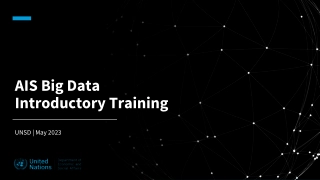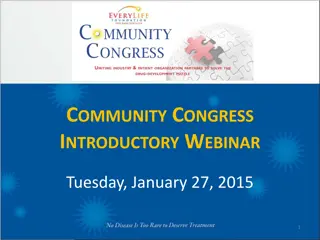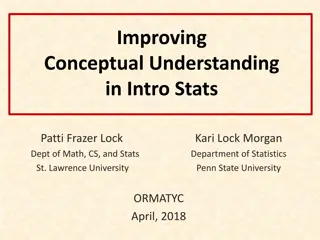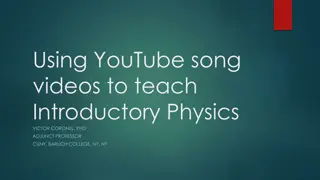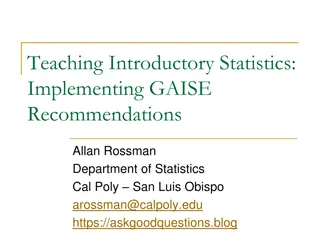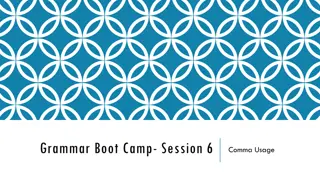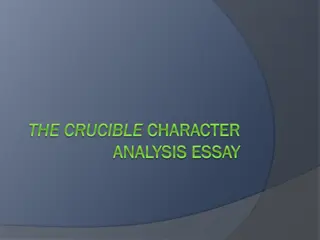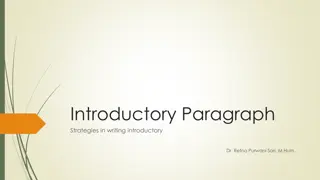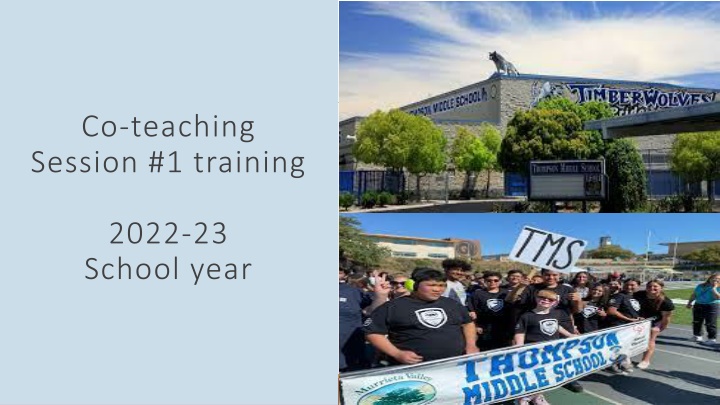
Co-Teaching Strategies for Effective Classroom Collaboration
Explore the significance of co-teaching in the 2022-23 school year, emphasizing the importance of collaboration between general education and special education teachers. Discover the various co-teaching models and how they benefit students with diverse learning needs to ensure academic success and college-career readiness.
Download Presentation

Please find below an Image/Link to download the presentation.
The content on the website is provided AS IS for your information and personal use only. It may not be sold, licensed, or shared on other websites without obtaining consent from the author. If you encounter any issues during the download, it is possible that the publisher has removed the file from their server.
You are allowed to download the files provided on this website for personal or commercial use, subject to the condition that they are used lawfully. All files are the property of their respective owners.
The content on the website is provided AS IS for your information and personal use only. It may not be sold, licensed, or shared on other websites without obtaining consent from the author.
E N D
Presentation Transcript
Co-teaching Session #1 training 2022-23 School year
Z The WHY, WHAT, and HOW of CO-TEACHING Why co-teaching? What is co-teaching? How to implement co-teaching? How to support students? How to support teachers? How to engage parents: IEPs, on-going communication, progress reports/report cards Co-teaching MOU for 2023-24
Z The WHY Allow our MVUSD students to benefit from: High quality instruction made possible through a collaboration between a content area expert (general education teacher) and an expert in providing differentiated instruction with accommodations/modifications (special education teacher) A learning experience in a classroom of students with diverse learning needs to better prepare our students for their post-school life of working, living, studying, collaborating with diverse individuals in college, career, family, community. Allow our MVUSD teachers to benefit from collaborating and counting on one another when providing instruction to students with high and diverse needs.
A CO-teaching at TMS TMS Mission: To support our students by building inclusive options; To provide access to grade level content for a diverse group of students; To give students of differing ability levels the opportunity to be on track to meet high school diploma and College-Career Readiness expectations; To build collaboration between core content teachers and Special Educators we are a team!
Z The WHAT A general education and special education teacher teaching together in the same classroom; Co-teaching models (1) One Teach/One Observe (2) One Teach/ One Assist, (3) Station Teaching, (4) Parallel Teaching, (5) Alternative Teaching, (6) Team Teaching; These models have been discussed and studied (Cook & Friend, 1995; Fenty & McDuffie-Landrum, 2011; Forbes & Billet, 2012; Hepner & Newman, 2010; Nichols, Dowdy, & Nichols, 2010; Sileo, 2011)
Z Co-Teaching models One teach, one assist
Z The WHAT: Co-Teaching Models (1) one teach, one observe requires no interaction from the observing teacher, just observations and study of how students are responding to instruction, collecting information on students needs to discuss with the co-teacher at a later time for the purpose of better addressing the students learning differences, motivation, engagement, and progress (2) when one teach/one assist is being used typically the general education teacher provides content instruction while the special educator drifts through the classroom assisting students that need additional help; (NOT JUST STUDENTS WITH SPECIAL NEEDS); (3) station teaching requires that the content be divided into three parts and each teacher is responsible for delivering a portion of content while a group of students work independently (students rotate until they have received all content); (4) parallel teaching requires that the class be separated into two groups while each teacher delivers the same content to their group; (5) alternative teaching requires that one teacher work with a small group to reteach, supplement, or pre-teach while the other teacher presents content to the large group; (5) team teaching requires both teachers take turns presenting content information to the large group. All of the models have their pros and cons, but the One Teach/One Assist model is the one most often implemented in the inclusion classroom (Harbort et al., 2007; Volonino & Zigmond, 2007; Zigmond and Matta, 2004).
Z Who SELECTs the co-teaching model? Co-teachers select the co-teach model; Co-teachers may alternate the models; Based on the unit and the needs, the model may shift or evolve (example, start with One Teach, One Assist and then move to Station Teaching)
Z The HOW: Co-Teaching IMPACT On LEARNING When asked about co-teaching, people answer that it is two teachers in the room, one delivers the lesson, the second teacher is a special education teacher who supports the special education students. This is not co-teaching. This is the push-in RSP model. Just like any teaching model, for it to be effective, it needs to be high-quality; High-quality means that the two teachers have clear expectations on their roles and implement their roles with fidelity; High-quality co-teaching means that all students who need support in the co-teaching classroom will get it, not just the students with disabilities; High-quality co-teaching also means supporting our co-teachers!
Z Team Teaching - Considered by some to be the golden standard of co- teaching; - It is not about the model; it is about student learning. Which of the models works for the two teachers and provides the best learning results for students?
Z Co-teaching Collaboration Instruction Clear roles/responsibilities Training on co-teaching, collaboration, and instructional strategies effective in a co-teaching classroom Planning time Administrative support
Z How will we support our Co-teachers? 1.Provide training (effective strategies and collaboration); 2.Provide planning time per MOU;
A Role of gen education teacher Takes the lead in developing instruction Plans and delivers daily lessons Responsible for common district assessments (formative and summative) Inputs attendance and grades Collaborates/consults with resource teacher re: individual student needs Communicates with parents Participates in content PLCs
Role of special education teacher A Provides bell-to-bell support Implements IEPs (accommodations, modifications, IEP goals) Leads small groups for re-teaching/reinforcement Collaborates/consults with general education teachers Communicates with parents Participates in content PLCs Collaborates in monitoring academic performance (grading) Supports engagement, anticipates and addresses behavior needs IEP Progress Reports and other special education responsibilities
Z Roles Please review your role (gen. ed. or special ed. teacher); Discuss with your co-teacher key responsibilities that fall under each bullet point; Share how you can assist your co-teacher with duties that fall under their role (example: parent communication);
A Attendance Students: Who is taking the lead currently on student attendance? Teachers: Both teachers must be present bell to bell for the co-teach model Avoid pulling students for testing and scheduling IEPs during your co-teach period Collab in other classes should also not be taking place during your co-teach period
A Grading Discuss the current process of grading special education students. oIs there a structure in place for analyzing student assessment data and outcomes? oWhat are you doing when the students "don't get the concepts oWhat is your process, plan, and questions?
A Parent communication Scenario: You received an email from the parent of a general education student participant in your co-teach class and Special Education parent of student participant in your co-teach class. Who answers the email? Do you share it with the other co-teacher? What is your process?
A Makeup of Classes Up to 50% students without IEPs, and 50% students with IEPs Make sure it is heterogenous General Education students (not the lowest Gen Ed students) - Shout-out to our TMS team for building heterogenous groups! Criteria for selecting SWDs for the co-taught classes Lexile Previous grades What class were the students in while in middle school (like pull out basic; use math pathways scores) Post high school goals Work habits/Attendance Teacher recommendation IEP Attendance should still be spread throughout all of the students Gen Ed Teachers!*** Remember this a TRUE Gen Education class- curriculum accommodations ONLY
Z Co-teaching vs. Collaboration Model Co-Teaching Purpose is to serve all students Intentional collaboration Intentional planning time Bell to Bell collaboration between two teachers Formal models of co-teaching exist All students who need are supported Accommodations/modifications are intentionally included into the lesson delivery (initial design) and are available to all students Both do grading Both have full access to: Aeries for gradebook/attendance Canvas Savvas/any online curriculum Teachers are equals Push-in Collaboration In-class support as needed/SAI minutes Input on grading for special education students only Have limited access to: Canvas Online curriculum Provide accommodations/modifications to students with IEP s only to access the curriculum
A PLC Participation Expectations (these may be revised next year) oAttend the grade level Math PLC for your co-taught class oYour grade level Special Education partner should attend and make the rounds to the other Core subject PLCs oContinue to attend your Special Education department meetings on department meeting days
A IEP Participation Expectations Do not overload your General Education co- teacher Continue to rotate who you are inviting to IEPs shout-out to TMS team for sharing the wealth in who you are inviting to IEPs!
Class Composition oNo more than 35% of special education students, unless the co- teachers agree to additional special education students, based on the need of the classroom; oThe classroom will not exceed 50% of special education students; oCo-teaching Class Agreement form is signed by both teachers.
Co-teaching Volunteer Form oCo-teaching Staffed with Volunteer Teachers, to the fullest extent possible oCo-teaching Volunteer for 2023-24 School year form
Co-teaching Required and Non-Required Courses oRequired: ELA, MATH at middle school level; English, Math, Biology at high school level oNon-required courses: If secondary co-teachers express interest in co-teaching a course that is not on the required list, they can submit a Non-required Co-teaching Course Proposal; oPrincipal reviews proposal and forwards to Executive Director of Secondary and Executive Director of Special Education
Substitutes oWe do not plan on pulling co-teachers to act as substitutes for other classes or to attend meetings during their co-taught class period; oWhen a co-teacher reports an absence, their position will be filled by a certificated substitute to the extent possible. Every effort will be made to ensure that are always two co-teachers available in a co- taught class period;
What co-teachers shared during the 2022-23 School Year oWe held meetings with all co-teachers at each of the middle schools during the 2022-23 school year
What co-teachers shared during the 2022-23 School Year o Special education students gave more effort and tried the hardest in front of their general education peers; oGeneral education students were able to help and learn more themselves because they were assisting a peer with an academic skill; oSpecial education teachers shared that they can support the students better now that they have been in the general education classroom bell to bell and have learned the curriculum and expectations; oGeneral education teachers shared that not worrying about accommodations, modifications, or other IEP requirements made them more confident about their instruction of all students; oAll students benefited from having access to many of the accommodations (they made them available to all students); oGeneral education teachers saw that the special education students more often than not are capable of doing the work, but do not want to do the work. oBoth teachers shared that they knew the students better and had more meaningful participation in IEP meetings
What co-teachers shared about challenges during the 2022-23 School Year o If the general education teacher is not organized, has planned instruction, and is not prepared; o If the special education teacher is not there (at an IEP, for example), it is hard to collaborate; o Some general education teachers were concerned about the DOK levels for general education students performing at a high level and, therefore, recommended to carefully consider which general education students should take the co-teaching class; oSome teachers were concerned about the lack of collaboration time. To address this, sub release is possible to swap for collaboration hours. You can start collaborating in the summer. oMore concerns were expressed in meetings that were held earlier in the year. Fewer to no concerns were shared at meetings at the end of the year. It does take time to get better and figure out things.. oHigh school co-teachers share only positive experiences. They have been co-teaching longer (before and during Covid).
Thank you all for all you are doing for our students! QUESTIONS OR IDEAS? HOW CAN WE SUPPORT YOU?

